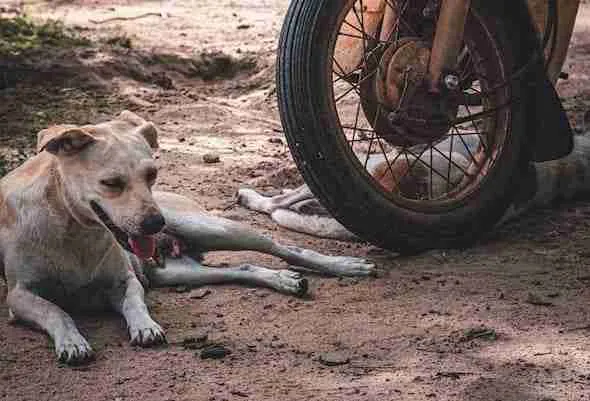Bali, an island in Indonesia, is known for its stunning beaches, lush landscapes, and vibrant culture. But there is the unfortunate issue with stray dogs around the island of Bali. Stray dogs are a common sight in Bali, particularly in more populated areas and tourist areas. So why are there so many stray dogs in Bali?
There are a number of reasons for stray dogs in Bali. Such as no sterilization, abandonment, economic factors, and tourists feeding the stray dogs. Currently, the government and local communities are also increasingly recognizing the importance of managing the stray dog population. And are implementing measures to address the issue. Which is a work in progress.
In this post, we will go through why are there so many stray dogs in Bali. Let’s get started!
Learn More On Bali
- Can You Bring Alcohol To Bali?
- Bali Travel Tips – Reasons NOT To Visit Bali!
- Is Sunscreen Expensive In Bali?
- How Much Is Scooter Rental In Bali?
- Can You Bring Alcohol To Bali?
- Is McDonald’s In Bali Safe?
- Can You Flush Toilet Paper In Bali?
Why Are There So Many Stray Dogs In Bali?
There are several factors contributing to the high population of stray dogs in Bali, these are as follows.
- Lack of Sterilization and Animal Control – The high number of stray dogs in Bali can be attributed, in part, to the lack of widespread sterilization programs and effective animal control measures. Uncontrolled breeding among owned and unowned dogs leads to an increase in the stray dog population.
- Abandonment and Neglect – Some dogs become strays due to abandonment by their owners. Economic factors, changes in circumstances, or lack of responsible pet ownership can lead to dogs being left on the streets.
- Tourism and Feeding Practices – Bali’s popularity as a tourist destination has resulted in a culture of feeding stray dogs by some tourists and locals. This unintentionally encourages the survival of the stray dog population and can contribute to their presence in certain areas.
- Cultural and Religious Factors – Balinese Hinduism holds a belief in karma and reincarnation, which can influence attitudes toward animals. Some locals may view the feeding and care of stray animals as acts of religious devotion. But may not focus on long-term solutions such as sterilization and adoption.
Efforts are being made to address the issue of stray dogs in Bali. Animal welfare organizations, both local and international, work on sterilization and vaccination programs, adoption initiatives, and public education campaigns to promote responsible pet ownership.

The government and local communities are also increasingly recognizing the importance of managing the stray dog population and implementing measures to address the issue.
It’s important for visitors and residents to support responsible tourism and contribute to sustainable solutions, such as supporting reputable animal welfare organizations, promoting sterilization programs, and adopting dogs from shelters instead of buying from breeders or pet shops.
Can I Touch Dogs In Bali?
While it is generally safe to touch dogs in Bali, it’s important to exercise caution and use common sense when interacting with unfamiliar dogs. Especially stray or street dogs. Here are some guidelines to keep in mind.
- Approach with care – If you encounter a dog you would like to touch, approach it slowly and calmly. Some dogs may be friendly and receptive to human interaction, while others may be wary or uncomfortable with strangers.
- Assess the dog’s behavior – Pay attention to the dog’s body language. Signs of aggression or fear, such as growling, bared teeth, raised hackles, or a stiff posture, indicate that the dog may not want to be touched or approached. Respect the dog’s boundaries and give it space.
- Seek permission from the owner – If the dog is with its owner or in a controlled environment, it’s courteous to ask for permission before touching or petting the dog. Not all owners may be comfortable with strangers interacting with their pets.
- Consider stray dogs with caution – Stray dogs in Bali may have had limited or no human contact and their behavior can be unpredictable. It is generally not recommended to approach or touch stray dogs without the guidance of experienced professionals or local animal welfare organizations.
- Practice good hygiene – After touching any dog, it’s advisable to wash your hands with soap and clean water, especially before handling food or touching your face. This helps minimize the risk of potential diseases or infections that can be transmitted through dog fur or saliva.
It’s worth noting that Bali has seen efforts to manage and control the population of stray dogs, including vaccination and sterilization programs.
Nevertheless, it is always important to prioritize personal safety and consider the specific circumstances when interacting with dogs, whether they are owned or stray.
What To Do If Bitten By A Dog In Bali?
If you are bitten by a dog in Bali, it’s essential to take immediate action to ensure your safety and prevent any potential complications. Here are the steps you should consider taking.

- Wash the wound – Thoroughly clean the wound with soap and clean water as soon as possible. This helps to remove any dirt or bacteria that may have entered the wound.
- Apply first aid – If available, apply an antiseptic solution or an over-the-counter antibiotic to the wound to help prevent infection. Cover the wound with a clean dressing or bandage to protect it.
- Seek medical attention – It is crucial to seek medical attention promptly, especially if the wound is deep, bleeding, or shows signs of infection. Visit a local medical clinic, or hospital, or contact emergency services for immediate care. The healthcare professionals can assess the wound, clean it more thoroughly, and provide appropriate treatment, including tetanus vaccination and antibiotics if necessary.
- Report the incident – Report the dog bite incident to the local authorities or your accommodation provider. They can assist with providing necessary information, guidance, and contact details for any required follow-up, such as reporting the incident to local animal control authorities.
- Rabies evaluation – In Bali, where there is a known risk of rabies, it is crucial to discuss the incident with medical professionals to determine the need for post-exposure prophylaxis (PEP) for rabies. They will assess the circumstances, and the dog’s vaccination status, and advise you accordingly.
Remember, these are general guidelines, and it’s important to rely on the expertise of medical professionals who can provide the appropriate care and advice based on your specific situation.
Prompt medical attention is crucial to minimize the risk of complications and ensure your well-being.
USEFUL TRAVEL RESOURCES
Book Accommodation
Booking.com has a large range of properties from hotels, hostels, guesthouses, and resorts where you will find the best deals. Airbnb and Hostelworld also have a good range of places to stay at good prices.
Booking Flight
Skyscanner is a flight search comparison website that searches millions of flights all at once. Ultimately it is the best flight comparison website online at the moment.
Booking Transportation & Things To Do
Rome2rio and 12Go are useful to plan how to get anywhere by searching train, bus, car, and ferry routes. Especially useful in countries like Vietnam or Thailand. While Klook is great for exploring things to do in each place.
Travel Insurance
Travel insurance is cheap and more than likely you will never need to use it but you will have peace of mind if something does happen, you are covered in case of an emergency. World Nomads have great customer service and competitive prices.
Check out our resource page for the best companies to use when you travel.
Wrapping Up
Finally, there are a number of reasons for stray dogs in Bali. Such as no sterilization, abandonment, economic factors, and tourists feeding the stray dogs. Currently, the government and local communities are also increasingly recognizing the importance of managing the stray dog population. And are implementing measures to address the issue. Which is a work in progress.
And that’s it for now! I’d love to know if this guide on why are there so many stray dogs in Bali has helped you. Let me know if you have any questions and let me know if there is more to add.
Did you enjoy this post? Then don’t forget to pin it!







